Aquaponics Project, part I, Tanks and Frames
I've been doing a bit of gardening, and I've decided to build an aquaponic garden. My problem with gardening is that most of my (small) yard is a bit short on sunlight, due to the overhanging trees, and the shape of the house, which surrounds the yard, and faces north. The only good spot for a garden is in the middle of the yard (courtyard, really), so I am aiming for something that will be decorative, and make a good centerpiece for the courtyard.
Now, aquaponics is where you grow plants in a soil-less medium in combination with raising fish. You cycle nutrient-rich water from the fish tanks through through the garden beds. This helps fertilize the plants, and in turn, the plants help clean the water for the fish. It's quite a nifty idea. It also uses little water, because you are constantly recycling the water in the system. For this reason it's getting to be popular in Australia, and should work well here, where water restrictions can be a problem. Also, since you can raise edible fish, like catfish, trout, tilapia, or freshwater perch in such a system, you can get fish and vegtables from the same garden.
It's a bit late in the season, but since this is a warm climate, there should be plenty of time for a good late-season crop of leaf vegtables, carrots, tomatoes and the like.
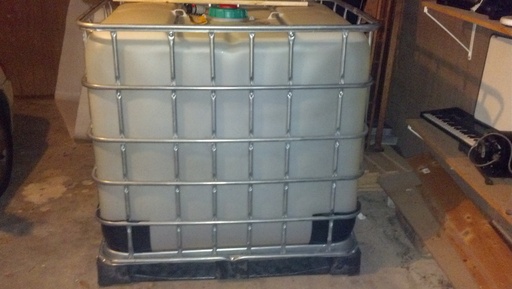
For this project, I will be using a pair of these IBC tanks as the basis. These are actually large commercial shipping containers for shipping bulk liquids (mine were used for shipping sugar syrup). These work well for this. they consist of a metal frame around a cube shaped plastic tank. They are easy to get (around here they are often sold as large rain barrels). I'm going to cut the tops off the tanks, and flip them upside down to make the garden beds, this will make two beds that are about 4 feet by 3 1/2 feet, and they will sit on top of the metal frame, which will form the structure. This will also raise the garden beds to about 3 to 4 feet above the ground, so I won't have to bend over to work on the garden.
The bottoms of the tanks will form the fish tanks (two 200 gallon tanks) and will be inside the frames in the bottom of the structure. (An open fish pond would be nice to watch the fish, but there is too many raccoons, feral cats and fish-eating birds around for that.) To make it look nice, I'm going to use some cedar boards on the outside, with hinged doors in the sides to get access to the fish tanks. The bottom structure will also house all of the pumps, plumbing, etc to make it all work.
The rule of thumb for these systems is you want 5-7 gallons of fish tank volume per pound of adult fish. You also want about a square foot of garden per pound of fish. My fish tanks are big enough for around 70 lbs of fish, but I'm only starting with around 25 sq. feet of garden bed, so that limits the amount of fish (I will probably add more garden beds later on).
Now, after removing the pallets bolted to the bottom, the metal frames are around 3-1/2 feet tall. With the garden beds, which are a foot deep, on top, this would make the finished garden a bit taller than I want. I could cut down the frames, but the fish tanks are 2-1/2 feet tall, and I want some space to access the fish, and to run the plumbing underneath, so, in order to lower the height, the first step here is to dig a big hole, like so:
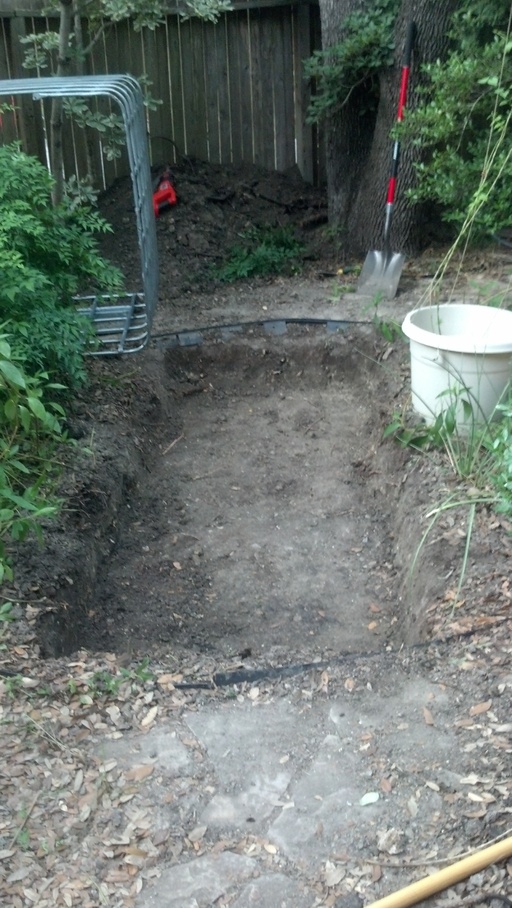
That hole is 8 foot by 4, and a bit over a foot deep. By the way, digging a hole that big, especially in the nasty clay that passes for soil hereabouts,
is a gigantic amount of work. Ugh. Minecraft did not prepare me for this.
Next, I place the frames, and fish tanks in place like so.
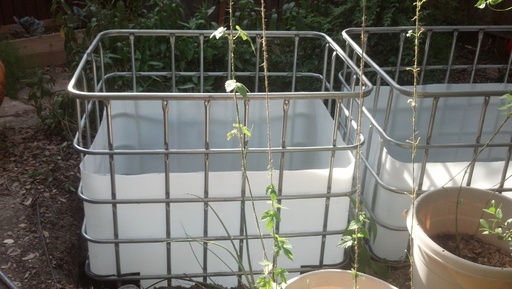
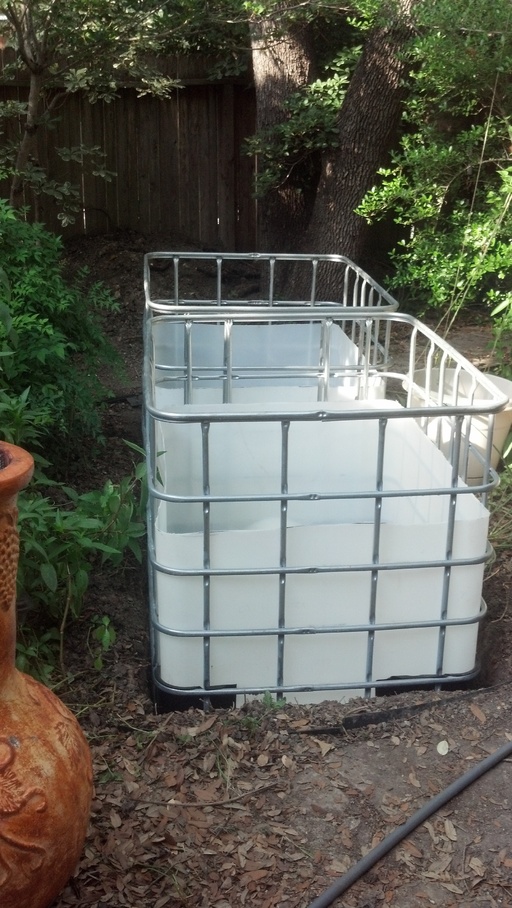
Then, I've connected the two fish tanks together. The tanks have a 2 inch threaded drain at the bottom with a valve. I'm using some 2 inch pvc pipe and fitings to connect them. This will let water flow between the two tanks. I will be gluing some screening (with non-toxic hotmelt glue) over the drains, so I can keep two different types of fish, and keep them in their own tanks (one of the common refrains from the aquaponics forums I read is: "You would not believe how small a pipe a large fish can (and will) swim though." Better safe now. There is few worse things for an aquaponics system than realizing you have a (potentially expired) fish stuck in a pipe. (One of those worse things, though, is realizing you have a (potentially expired) fish stuck in a valve. The worst thing being that you have half a (definitely expired) fish stuck in a valve. ("So that's why that was so hard to close!"))):
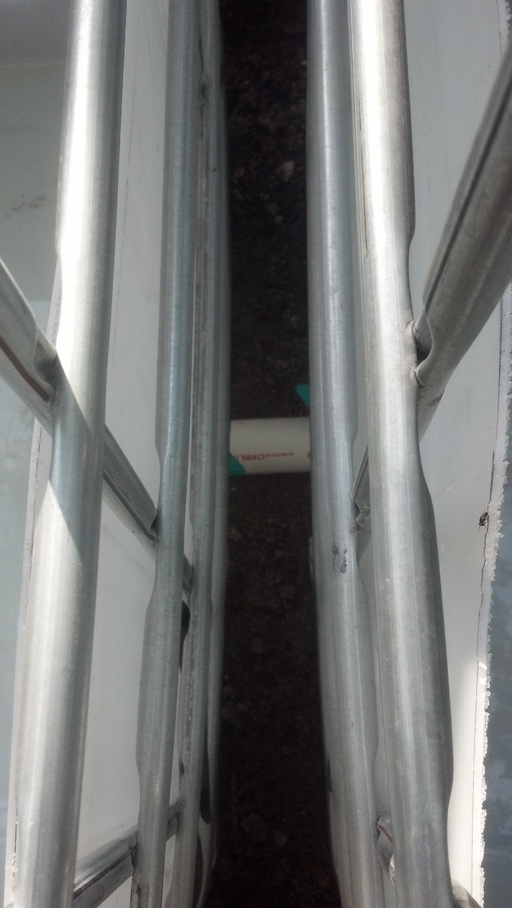
Now, just do a test fill of the tanks to make sure nothing leaks. Taa-dah!:
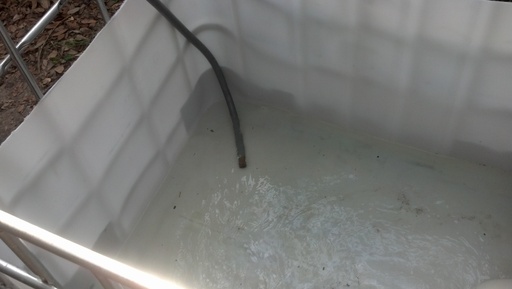
Next up: Building and attaching the garden beds.